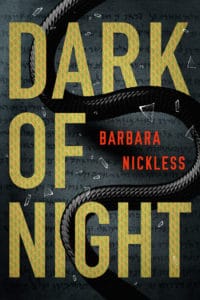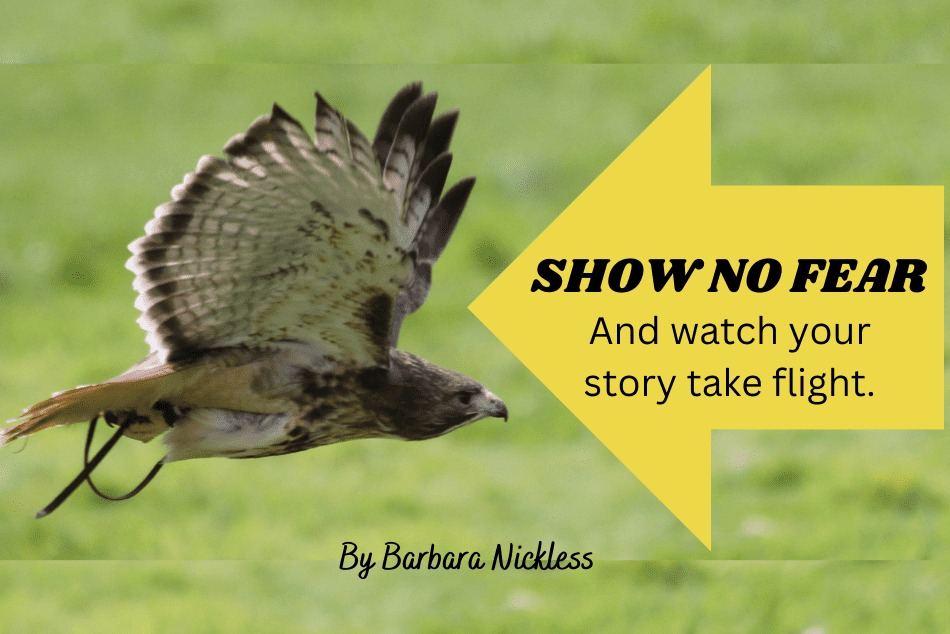Show No Fear: What I Learned About Mystery Writing by Helping Injured Birds of Prey
Barbara Nickless
The hero of my newest thriller series, Dr. Evan Wilding, is a forensic semiotician. He studies the signs and symbols, the writings and drawings left by criminals. Killers—especially serial killers—love to create a story to explain their actions. And then leave traces of that story at their crime scenes.
When he’s not chasing criminals, Evan gets great pleasure flying his goshawk, Ginny. Ginny is immense, with a wingspan of nearly four feet. She is fierce, solitary, a predator. Evan is none of these things. But he and Ginny enjoy a mutual respect.
When writing the scenes between Evan and Ginny, I drew on my years rehabilitating injured birds of prey. I started my training with John Karger, the founder of Last Chance Forever, and continued my work at the Pueblo, Colorado, Raptor Rehabilitation Center. At the Center, it was my job to exercise the birds. I would enter a pine-slat cage, capture the hawk or falcon, the vulture or eagle, and hold the bird tightly while I attached jesses—leather straps—to its legs. Next, I would thread a creance line through slits cut in the jesses. Once tethered to a long line, the bird could fly—but it could not flee. Not until it was healthy enough to return to the wild. I’d carry a bird outside and, depending on the bird’s health, fling it into the air or set it gently on a perch. I’d grip the end of the creance line and watch the bird circle overhead.
Keep in mind these were wild creatures. They were not trained to come to the glove. They were kept deliberately apart from humans as much as possible to avoid habituation. And they were royally pissed about all of it. I had never felt as vulnerable as I did the first time I force-fed a bald eagle.
I’m now writing the third book with Evan and Ginny (Play of Shadows, 2023). And while revisiting my memories of my time among these predatory birds, I realized that several things I learned working with them also apply to writing.
It’s not as scary as you think
Wrestling birds of prey and writing are daunting. But if you are committed to the work, properly armored with the tools of your trade, and willing to take some risk, you will lose any fear you have as you give yourself over to the job. And it will be all right. More than all right. It will be wonderful.
But it’s still scary. So, get an eagle glove. One day I was tasked with entering a human-sized enclosure to grab a bird that was first on the docket to be exercised. The pine slats were placed tightly together, making it impossible to see inside the dark space. All I knew was that whatever was on the other side of the door was making a horrific racket: a battle rattle of unmitigated fury. I’d started the day wearing an ordinary falconer’s glove. But when I heard that keening cry, I went back for the eagle glove with its thicker leather and a length that stretched from the tips of my fingers to my shoulder. My assistant placed himself near the door and waited while I ginned up my courage. The bird continued its frenzied shrieks. After a moment, I nodded at my assistant, who unlatched the door and scurried aside.
Out flew a bird the size of a baseball. It whizzed past my head and disappeared into the rafters. An hour later, with the help of a ladder and a smaller glove, I’d extracted the tiny screech owl from its hiding place and taken it out into the sunlight and blue sky. It was, in fact, the beginning of a beautiful friendship.
This was a classic case of bringing a gun to a fistfight. But if the bird that came at my face been a harpy eagle, I would have had the right tool. I would have been prepared for whatever that frightened furious beast was prepared to dish out. The idea here is to approach your writing the way I approached that unknown bird: by being prepared. When you’re ready to tackle that novel or write a short story, armor up. Read fiction by the best authors. Study the craft with books like Stephen King’s On Writing or A Swim in the Pond by the Rain by George Saunders. Find a critique group that will give you kind but honest feedback. And keep practicing. Maybe your story will be tight and manageable. But if it’s a beast, you’ll be ready.
Get to know your adversary
Once, a bird came at my face, and this time it was not a timid screech owl. This was a huge, female ferruginous hawk, and she was having a very bad, no good, horrible day, of which I was the biggest part. As I cradled the bird in my lap, working to attach the jesses, I had a moment of distraction. Quick as a killer’s scalpel, that bird freed one leg and plunged a talon into my cheek. I kept working. I got the jesses on, attached the creance line, then passed the hawk over to another handler while I—much chastened—went to the emergency room. If you’ll forgive me for casting the hawk as the villain in this story, this incident serves as a lesson to know what motivates your killer and what sneaky actions he might take to hurt or elude his hunters while they’re looking elsewhere. It is important to know what the killer is doing in the point-counterpoint that plays out between the detective and the criminal.
On bad days, remember your larger purpose
We all have our personal reasons for writing. But I think most writers want to bring something to our readers. We want to entertain, to distract people from their troubles. Or maybe our goal is to highlight an important issue, to bring understanding to readers who might not otherwise have the chance to walk in someone else’s shoes. My goal with the birds was to open their horizons, to give them back a chance to fly free and make their own way in the world. With my readers, I also hope to open unimagined horizons.
Finally, show no fear
Especially not to yourself. Enter your workspace calmly, with a commitment to do the work no matter what comes at you that day. No matter if it’s a tangled creance line, an unusually uncooperative falcon, or a blank screen and words that simply will not flow, keep at it. Stay calm, be patient, and stay the course. The bird—or the story—will follow.
What do you do when your a barraged by fear of your page? Let’s talk about it on the Career Authors facebook page! And then–get writing!
 Barbara Nickless is the Wall Street Journal and Amazon Charts bestselling author of the multi-award-winning Sydney Parnell crime novels. Her new series features forensic semiotician Dr. Evan
Barbara Nickless is the Wall Street Journal and Amazon Charts bestselling author of the multi-award-winning Sydney Parnell crime novels. Her new series features forensic semiotician Dr. Evan  Wilding—a man whose gift for interpreting the words and symbols left behind by killers has led him to consult on some of the world’s grisliest cases. “Dr. Evan Wilding is absolutely my new favorite fictional human.” (Danielle Girard, USA Today & Amazon #1 Bestselling Author of The Ex.) Barbara lives in Colorado at the foot of the Rocky Mountains where she loves to hike, cave, snowshoe, and drink single malt Scotch. Connect with her at www.barbaranickless.com.
Wilding—a man whose gift for interpreting the words and symbols left behind by killers has led him to consult on some of the world’s grisliest cases. “Dr. Evan Wilding is absolutely my new favorite fictional human.” (Danielle Girard, USA Today & Amazon #1 Bestselling Author of The Ex.) Barbara lives in Colorado at the foot of the Rocky Mountains where she loves to hike, cave, snowshoe, and drink single malt Scotch. Connect with her at www.barbaranickless.com.





